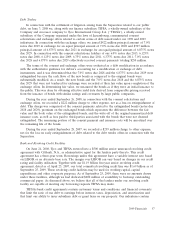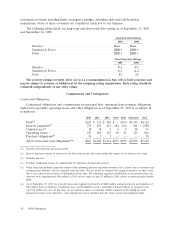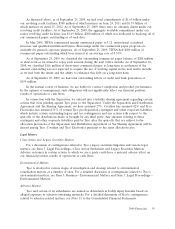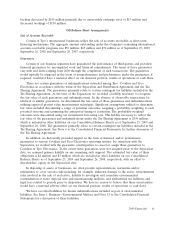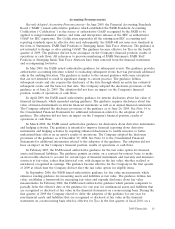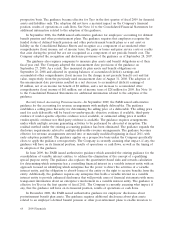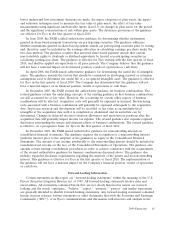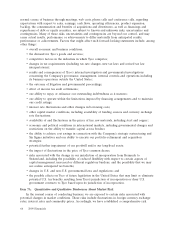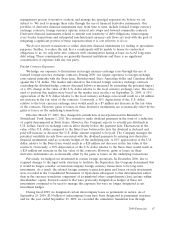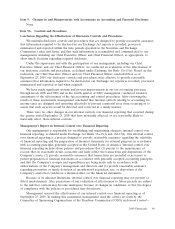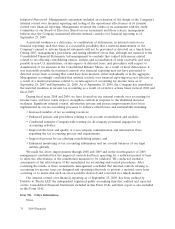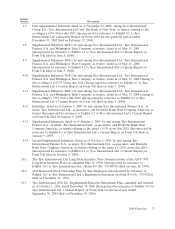ADT 2009 Annual Report Download - page 155
Download and view the complete annual report
Please find page 155 of the 2009 ADT annual report below. You can navigate through the pages in the report by either clicking on the pages listed below, or by using the keyword search tool below to find specific information within the annual report.Accounting Pronouncements
Recently Adopted Accounting Pronouncements—In June 2009, the Financial Accounting Standards
Board (‘‘FASB’’) issued authoritative guidance which established the FASB Standards Accounting
Codification (‘‘Codification’’) as the source of authoritative GAAP recognized by the FASB to be
applied to nongovernmental entities, and rules and interpretive releases of the SEC as authoritative
GAAP for SEC registrants. The Codification supersedes all the existing non-SEC accounting and
reporting standards upon its effective date and, subsequently, the FASB will not issue new standards in
the form of Statements, FASB Staff Positions or Emerging Issues Task Force Abstracts. The guidance is
not intended to change or alter existing GAAP. The guidance became effective for Tyco in the fourth
quarter of 2009. The guidance did not have an impact on the Company’s financial position, results of
operations or cash flows. All references to previous numbering of FASB Statements, FASB Staff
Positions or Emerging Issues Task Force Abstracts have been removed from the financial statements
and accompanying footnotes.
In May 2009, the FASB issued authoritative guidance for subsequent events. The guidance provides
authoritative accounting literature related to evaluating subsequent events that was previously addressed
only in the auditing literature. The guidance is similar to the current guidance with some exceptions
that are not intended to result in significant change to current practice. The guidance defines
subsequent events and also requires the disclosure of the date through which an entity has evaluated
subsequent events and the basis for that date. The Company adopted the disclosure provisions of the
guidance as of June 26, 2009. The adoption did not have an impact on the Company’s financial
position, results of operations or cash flows.
In April 2009, the FASB issued authoritative guidance for interim disclosures about fair value of
financial instruments, which amended existing guidance. The guidance requires disclosures about fair
value of financial instruments in interim financial statements as well as in annual financial statements.
The Company adopted the disclosure provisions of the guidance as of June 26, 2009. See Note 14 to
the Consolidated Financial Statements for additional information related to the adoption of the
guidance. The adoption did not have an impact on the Company’s financial position, results of
operations or cash flows.
In March 2008, the FASB issued authoritative guidance for disclosures about derivative instruments
and hedging activities. The guidance is intended to improve financial reporting about derivative
instruments and hedging activities by requiring enhanced disclosures to enable investors to better
understand their effects on an entity’s results of operations. The Company adopted the disclosure
provisions of the guidance as of December 27, 2008. See Note 14 to the Consolidated Financial
Statements for additional information related to the adoption of the guidance. The adoption did not
have an impact on the Company’s financial position, results of operations or cash flows.
In February 2007, the FASB issued authoritative guidance for the fair value option for financial
assets and financial liabilities. The guidance permits an entity, on a contract-by-contract basis, to make
an irrevocable election to account for certain types of financial instruments and warranty and insurance
contracts at fair value, rather than historical cost, with changes in the fair value, whether realized or
unrealized, recognized in earnings. The guidance became effective for the Company in the first quarter
of 2009 at which time the Company did not elect the fair value option for eligible items.
In September 2006, the FASB issued authoritative guidance for fair value measurements, which
enhances existing guidance for measuring assets and liabilities at fair value. The guidance defines fair
value, establishes a framework for measuring fair value and expands disclosure about fair value
measurements. In February 2008, the FASB issued authoritative guidance which permits companies to
partially defer the effective date of the guidance for one year for nonfinancial assets and liabilities that
are recognized or disclosed at fair value in the financial statements on a nonrecurring basis. During the
first quarter of 2009 the Company elected to defer the adoption of the guidance for one year for
non-financial assets and liabilities that are recognized or disclosed at fair value in the financial
statements on a nonrecurring basis which is effective for Tyco in the first quarter of fiscal 2010, on a
2009 Financials 63






